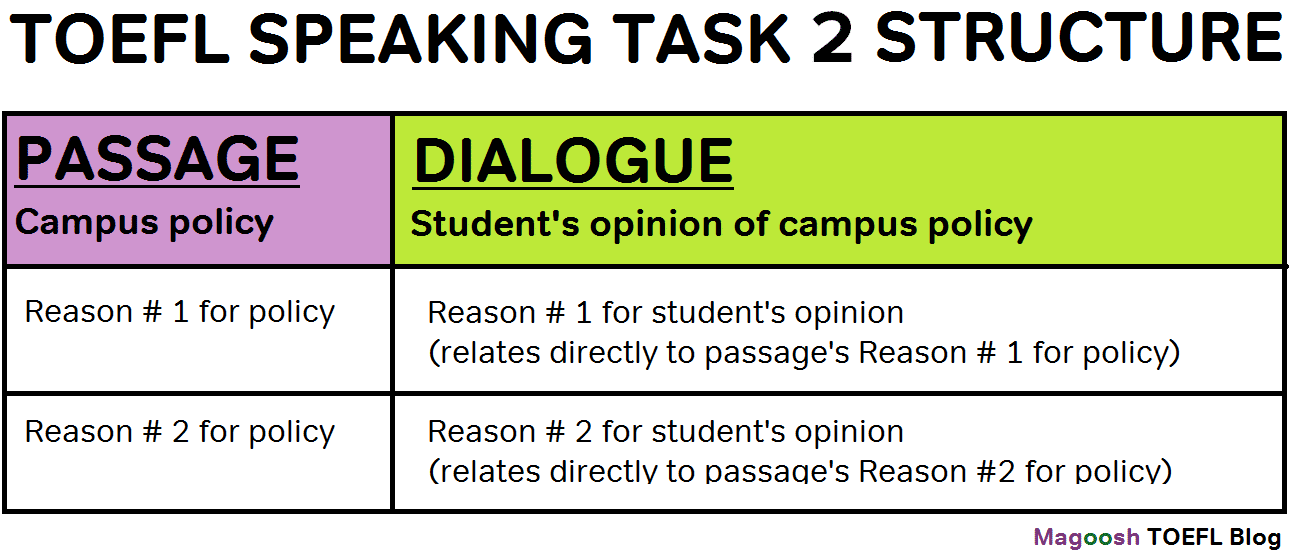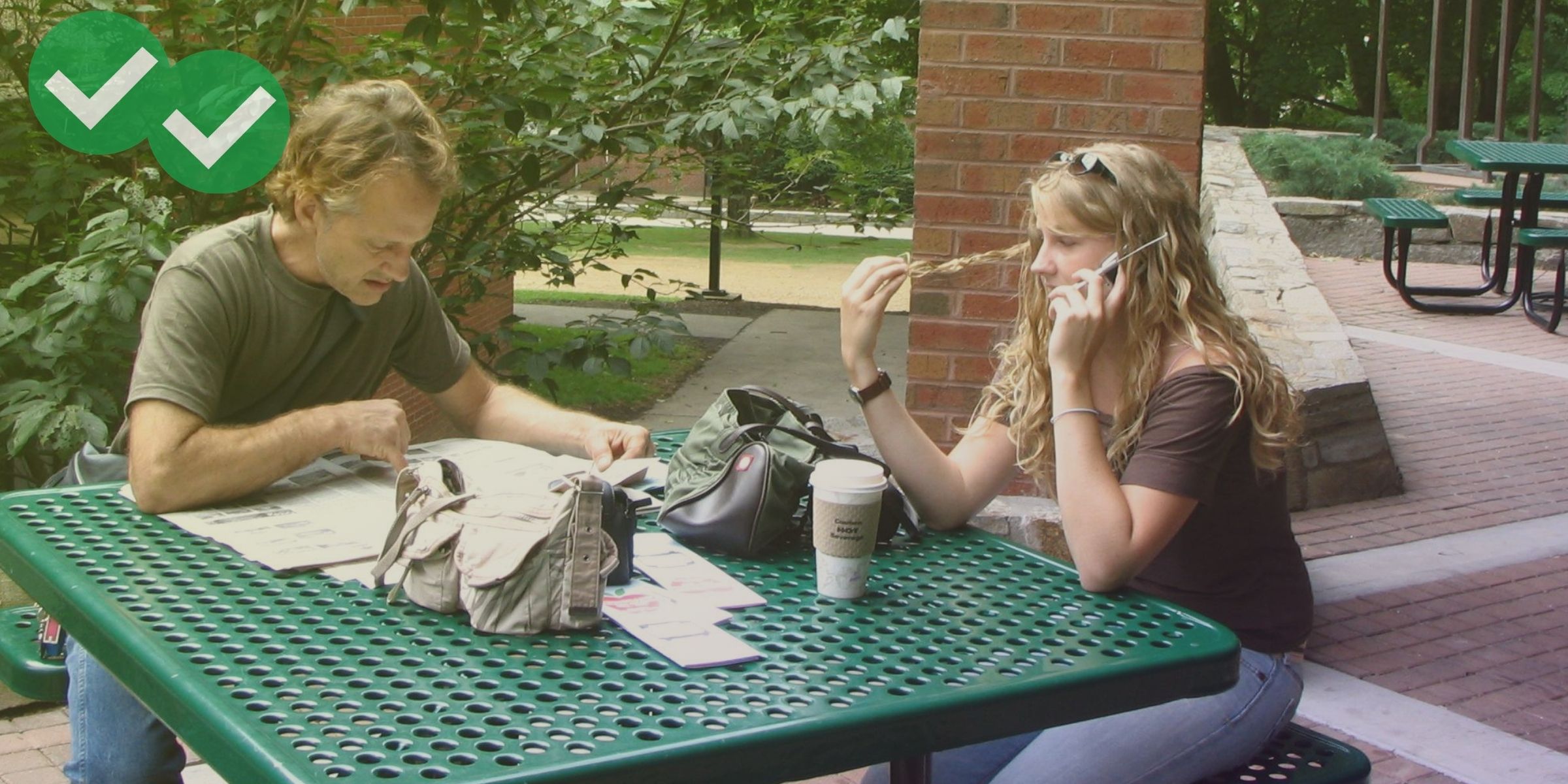
For many of the students I work with, TOEFL Speaking Task 2 is one of the hardest parts of the Speaking Section. The prompt is so packed with information!
The Complexity of TOEFL Speaking Task 2
In fact, you could even say that the TOEFL Task 2 Speaking prompt is deceptively complicated. At a glance, the task looks simple.
The passage is very short, and so is the audio track. But both cover a complex, argumentative structure. In 100 words or less, the passage will describe a policy or plan that affects students on campus, and will give two supporting reasons for the policy.
Then in one minute or slightly less, two students will have a conversation about the written announcement. But here’s the important part — only one of those students will give information that’s actually important for completing the task. That student — the opinionated one — will either approve or disapprove of the policy from the article. And said student will give two reasons for why they hold their opinion. The students’ two reasons will each directly address the two reasons for the proposed change in the original article.
TOEFL Speaking Task 2 in a Chart
If you got a little confused while reading the above description of Task 2, don’t feel bad. I almost started to feel confused as I wrote it! Actually, the information in the TOEFL Speaking Task 2 prompt can be broken down a lot more clearly in table form:

How This Structure Affects TOEFL Prep
As you prepare for the exam, knowing this structure can help you take good notes. Use the chart above to build your note-taking strategy for the task. You’ll know exactly how many ideas to listen for in the conversation. And once you start listening to the student talk about the passage, you’ll already have some idea of what the student’s going to say. This definitely helps you take effective notes.
This can also help you avoid any unofficial practice materials for Task 2 that aren’t truly TOEFL-like. If you are going through a Task 2 prompt form a privately published book or website and you don’t see this structure, then you know the prompt isn’t fully preparing you for the real test. On any non-ETS TOEFL Task 2 prompts, read the passage carefully and make sure you can see a clear university policy and two clear lines of reasoning for the policy.
Then make sure that the opinionated student in the dialogue is directly responding to the policy from the TOEFL Task 2 reading passage. In a truly useful Speaking Task 2 practice prompt, the student will have a clear opinion about the campus policy, and will support their opinion by directly responding to both of the passage’s stated reasons for the policy.
IMPORTANT: The varied Nature of TOEFL Speaking Task 2
As you consider the structure of TOEFL Speaking Task 3, remember the the structure can vary a bit. In the conversation track of TOEFL Speaking Task 2, the speaker often disagreews witht he passage. But they may also agree, or, in very rare instances, partlya gree and partly disagree.
This varied nature of the TOEFL Speaking Task 2 audio dialogue is easy to forget. After all, the majority of the time, the opinionated student in the TOEFL Speaking Task 2 conversation will disagree with the policy in the passage. However, somewhere between 10 to 20% of the time, the student will agree with the passage. In this case, the student will add their own extra arguments in favor of the policy, on top of the supporting details in the reading itself. And still another 2% of the time or so, there will partial agreement and partial disagreement, where the student adds arguments in favor of some aspects of the policy, while arguing against other aspects.
If the student actually agrees with sof or all aspects of the passage’s policy — and its arguments in favor of the policy — this changes the structure of your own answer. Instead of summarizing an argument and counter-argument, you are summarizing a written argument and then a spoken argument that supports or at least partly the written argument in greater detail. When this happens, TOEFL Speaking Task 2 becomes bit more like TOEFL Speaking Task 4, where you read a passage and then listen to a lecture that expands on the passage.
How to Prepare for the Alternate Format of TOEFL Speaking Task 2
Because you have a 10-20% chance of getting this alternate format of the Speaking Task 2 prompt, it helps to prepare. One of the best ways to prepare is by using a good template for the task.
Recently, I showed you two different templates that can help you catch every important detail in this prompt, and appropriately connect the reading and the listening. The first TOEFL Speaking Task 2 template I showed you is based on an outline. The second TOEFL Speaking Task 2 Template is based on a flowchart.
The last two templates I showed you are meant to be flexible enough to work for either Task 2 format. But for the extra cautious TOEFL prepper, it may help to make two different templates — one for each possible direction the audio conversation could go. In my next post, I’ll show you a template that separately covers both possible audio responses to the Task 2 reading.





